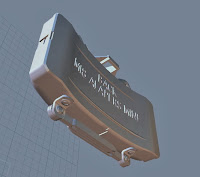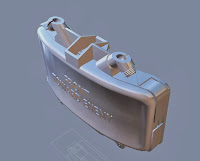

This was supposed to be a simple one to pad out the new set a little. Until I found out two things; a lot of people have modeled these so you can't cheat the details like you could with something less familiar to the audience, and; they have a lot more weird little curves and divots than I remembered.
(Yes, the legs are there. But I built them in stowed position to get the dimensions right, and I'll unfold them after I've rigged the thing. The model is done, but I still have to clean up the UV maps.)
I also realized why I'm not using automated mesh tools that much -- why I'm manually struggling vertex by vertex more often than not. That's because the automated tools in Carrara suck. The decimate tool, for instance, has never done anything useful. The edge tools have all sorts of peccadilloes (not limited to removing all mesh groups and welding all the proximate vertices in the entire mesh -- but that in itself is plenty!)
I wrapped the letters around the curved front with one of Carrara's Object Modifiers. Which rotated the mesh whilst bending it, making a nice round of flipping between different tools just to put the bend in. Then of course had to commit the bend via "convert deformed object to mesh" -- which basically shat all over the mesh. Took me almost an hour of manual clean-up.
It didn't even add all the garbage vertices and edges in a sensible way. Many of them were orthogonal to the bend, meaning they had no need to be there and in fact interfered with the smooth bend!
This is what really gets me about Carrara these days. Using it is like getting lectured by someone who hasn't been in the field himself for decades. Many times when you click on a tool (or even open a mesh), some "nag" notice pops up with some snide statement about how what you tried to do is bad modeling technique and even if Carrara permits it you won't be happy with the results.
Except. Except Carrara disobeys these frequent sneering adjuncts constantly with its own tools. Apply the text tool. It creates a mesh that Carrara will later claim is impossible and wrong.
You know, back in version 2 and 3 you could build with scaffolding, copying a set of edges and lofting off them. It made it really fast to create complex shapes. Now something as simple as the letter "A" is a huge fricking pain. Because Carrara can't understand the concept of a hole in a mesh, and tries to fill in the center of the "A," and when you try to delete the extra poly, extra-extra helpful Carrara helpfully delete all the edges as well! Because of course the edges would be naked otherwise, and exposed edges are bad modeling. So the software makes sure not to let you fix what it just screwed up.
Yes, it is long time that I stopped whining and moved on. I am moving on. I'm deep in the Blender manual and I almost understand the basic work method there now.
But I want to let this be known. I purchased Carrara when it first came out. Carrara Studio 1. I purchased it because I'd used two or three versions of Ray Dream before that and Carrara was the inheritor of that software. And it wasn't all bad; Carrara added basic mesh tools, eventually even edge tools and subdivision surfaces. And it also added what was when it came out a very nice render engine; fast as all heck, and the first realistic out-of-the-box lighting model I'd ever worked with.
But each new upgrade broke a new part of the modeling workflow, and failed to substitute a working alternative (as in, the methods they wanted you to use, were broken and they hadn't gotten them to work right yet.) And each upgrade was full of promises that it would get better. And I dumped hundreds of dollars in that rat hole.
Nice work, some of the best out there. Are you interested in sell a copy of this. I would like to print it in 3/4 scale for a project I have in mind.
ReplyDeleteG.H.Pearce
Hrm. Easiest way is to change the flag on my Shapeways store allowing you to download the STL. At 3/4 scale that would be a rather expensive print at Shapeways, plus you'd do well to take it into Meshworks or something and shell it (the version I've been printing is 1/6 scale and thus solid).
ReplyDelete